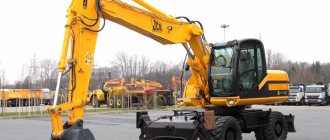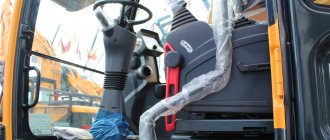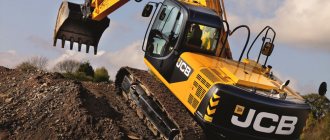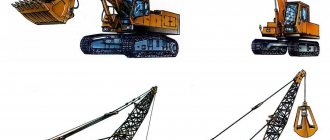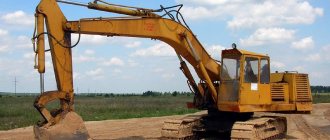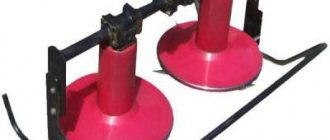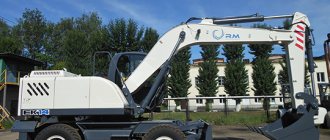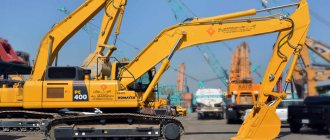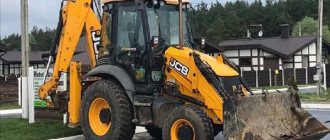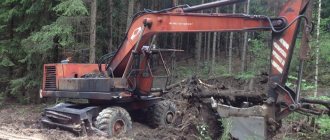Special excavation equipment has always been considered one of the most structurally complex types of construction machines. This is due to the fact that the mechanisms must not only provide traction force for the movement of the main platform, but also transmit it to the working parts. Against this background, an excavator on wheels is especially noteworthy, which must combine both high power and considerable dynamic performance. In any case, such vehicles are superior to their tracked counterparts in speed and maneuverability. True, it is not without its drawbacks. The fact is that a wheeled excavator has limitations for operation in swampy areas and problematic soil with insufficient bearing capacity.
In addition, models on wheels often have lower technical characteristics - this, by the way, is observed in load capacity, engine power potential, and digging depth. However, there are different versions of this technology on the market, a review of which will allow you to make the right choice.
Models from Komatsu
Today, the Japanese brand presents three versions of the sixth generation of its wheeled excavators. The new equipment is equipped with an EMMS system, which has three operating modes. In particular, the wheeled excavator will be able to operate with the expectation of working with increased force, in an economical mode, as well as in a hydraulic hammer format. There is also an additional mode that provides a lifting function. For user convenience, all information about the operating parameters of the machine is displayed on the LCD screen.
There are also seventh generation models in the Komatsu line. These are modifications equipped with diesel engines with a power of 118 kW and a volume of 6 liters. A special feature of this technology is its focus on the Russian climate. For example, some spare parts for Komatsu excavators are specifically designed for use in harsh conditions - this, in particular, applies to fuel system elements with a water separator. Also included as standard is an air filter and air conditioning to maintain optimal cabin pressure. The gearbox serves three operating modes, including slow, standard and transport, allowing the vehicle to move at speeds of up to 35 km/h.
Big Muskie
Big Muskie was created in 1969 by an American company and worked continuously at a coal mine until 1991. The model is still considered the largest example of a walking dragline excavator. With a total weight of 13,000 tons and dimensions of 48 m/66 m/149 m (H/W/D), the vehicle had the following operating parameters:
- bucket volume/weight - 170 m³/210 tons;
- The lifting and walking mechanisms were powered by 2 electric motors with a total power of 1625 hp. With;
- the length of the boom with a flexible chain tie is 90 m.
JCB excavators
Manufacturer JCB does not ignore this segment either, actively developing its model line. In recent years, the company has upgraded existing models, including the JS200W and JS1160W, and also introduced new ones – the JS175W and JS145W. Today, the JCB wheeled excavator is equipped with AMS electronic controls, comfortable cabs with FOPS protection system, as well as Isuzu diesel units, the power of which reaches 102 kW.
The dual-range Power Shift transmission allows the excavator to move at speeds of about 30 km/h. Slow travel at 3.8 km/h is also available. The company has provided a wide range of devices and mechanisms as functional equipment. In particular, articulated or monoblock booms, three types of handles, different options for buckets, hydraulic hammers, grabs and destructive units are offered. There are usually no problems with the maintenance of JCB equipment, but along with the model update, the company has also provided more reliable spare parts for wheeled excavators. This applies to glow plugs, batteries, Plexus hydraulic system filters, as well as other parts and components.
Hyundai models
In the case of Hyundai, you should immediately focus on the Robex line of excavators. In just 5 years, the company has grown to the production of fourth-generation machines, which indicates the introduction of the latest developments. It’s worth starting with the engines that the Hyundai excavator is equipped with in different versions. The manufacturer equips the equipment with two diesel units – Cummins B and Mitsubishi units. The control system is implemented by the SARO complex, which has three modes. By the way, the user can save control settings in the system. Modern options are also available to the operator. This is, for example, the possibility of digging force by 10% and instantaneous speed reduction.
The approach of Japanese developers to the functional support of equipment is also interesting. Outriggers and blades are available for any version. Only the seventh generation Hyundai excavator can get monoblock and articulated booms at the same time. For other versions, several handles and buckets are available - the exact number depends on the modification.
New Holland
New Holland has five basic models – MH2.6, MH3.6, MH5.6, MH6.6 and MH8.6, weighing from 10 to 23 tons; the company also offers them in special versions. Unlike competing companies, the model’s markings are not “telling”. Compact models МН2.6 and МН3.6 are made with a reduced turning radius of the platform for ease of work near the wall and on the roadway. Both axles are steerable. There are three steering modes - wheels only on the front axle, coordinated rotation of the front and rear wheels and diagonal travel. Working equipment - with a two-link boom and a rotation mechanism on the boom support. The excavators are equipped with 4-cylinder CNH diesel engines with a power of 79 and 84 kW. “Older” models are made in accordance with industry traditions, with a full-size rotary platform. They are equipped with monoblock or two-link booms to choose from. Power plants are 6-cylinder in-line CNH diesel engines.
Hitachi models
The manufacturer Hitachi offers four versions, including representatives of the ZAXIS line. The models of this company have long been known to the European and domestic markets, but there are also innovations added in the process of recent restyling. For example, modern modifications are distinguished by a reinforced rotating base and a cabin with a more robust design. The creators are also working to increase the service life of friction mechanisms. Thus, in the latest modification, the Hitachi full-rotary wheeled excavator is capable of operating for up to 500 hours without service. The differences between the models include the use of polymer gaskets, which are used in the brackets for fixing the boom to the base. As for the power filling, Isuzu diesel engines are used. For ease of maintenance, the designers have made the oil filter with a water separator more accessible.
Volvo excavators
also pays a lot of attention to the production of special equipment. Not long ago, the manufacturer began supplying wheeled excavators with a gross weight of 14 to 20 tons. The manufacturer supplies each model with its own diesel engines, which are reliable and economical. Also, the Volvo wheeled excavator has a gearbox that is provided with enhanced protection and fuses that do not allow abrupt switching from a high speed range to a lower one. By the way, the minimum speed limit is up to 3 km/h. If the equipment moves downhill, the hydraulic transmission motor will act as a retarder.
Mini models of wheeled excavators
Almost all manufacturers of special construction equipment produce compact and maneuverable mini-excavators, which are not very productive, but are indispensable in tight operating conditions. Today, this category is represented by small-sized models weighing no more than 12 tons. On average, the weight of such a machine is 8 tons.
In terms of functionality, such models also have something to boast about. The equipment is equipped with rammers, hydraulic hammers, mechanical grips, tongs, leveling boards and clamshell buckets. However, mini excavators still provide fairly weak digging force compared to their full-size counterparts.
Bagger 293
The world's largest rotary, self-propelled, mining excavator, Bagger 293, was developed by the German company Takraf in 1995. Its design is designed for continuous work on digging heavy soils using several buckets rotating on a rotary wheel. Today this mega machine operates in Germany, digging brown coal in open pits. Excavator characteristics:
- daily productivity - 230 m³ of rock;
- rotor wheel diameter - 22.6 m;
- the number of buckets on the wheel is 18 pcs, the productivity of each bucket is 15 m³;
- total vehicle weight - 14,200 tons;
- length - 228 m;
- 5 operators are required for maintenance.
What characteristics are important when choosing?
As practice shows, you should pay attention to every little thing when choosing an excavator. This applies to the size of the equipment, the functional content, and the controls. Much also depends on the engine power and the speed at which the equipment moves. Manufacturers think through all the nuances and strive to offer wheeled excavators in several versions. Thus, the consumer has the opportunity to provide for both operation on problematic soil and work with heavy material, and at the same time not forget about the area of the working area.
Caterpillar
At the beginning of 2007, Caterpillar announced the start of deliveries to the European market, including Russia, of wheeled excavators of the new D series - M313D, M315D, M316D, M318D and M322D weighing from 13 to 22 tons, replacing the previous C series excavators. In the new series, special attention focused on productivity. By increasing engine power, the speed was increased to 37 km/h - 10% higher than its predecessors. The new electronic engine management system is designed to optimize the performance of Cat C4.4 and C6.6 ACERT diesel engines and achieve better efficiency, especially when hauling an excavator. In particular, the hydraulic fan drive is switched on when necessary. For the D series, a high-capacity mode has become standard. By pressing the corresponding button, the operator increases the lifting capacity by 7% without slowing down the speed of movement of the working equipment.
The cabin has been completely redesigned to improve comfort and safety, with improved visibility and ergonomics. The new LCD monitor with color graphical interface and multi-language support is easier to understand. The menu structure has been redesigned to make it easier to use and includes five main items. Upon request, a surveillance camera will be installed at the stern, the image from which is displayed on the monitor. Heated mirrors are also available on request.
Another feature of the D series is automatic gear shifting; this function is activated by the corresponding button. The system of preset modes for attachments has been further developed: their number has been increased to 10, including modes with medium and high pressure in the additional hydraulic circuit. The hitch is controlled by rollers built into the joysticks.
SmartBoom work equipment, which was previously installed on tracked excavators, is now available for wheeled excavators. It provides greater productivity and easier, easier control in many applications, including digging, grading and hammering.
The engine service interval is 500 hours. The range of options has been expanded, including a second high-pressure valve required for working with a dual-circuit hitch - hydraulic shears or a grab with a rotator, a centralized lubrication system, LED rear optics, a special package for robots in landfills, as well as a system stabilization with gas batteries.
